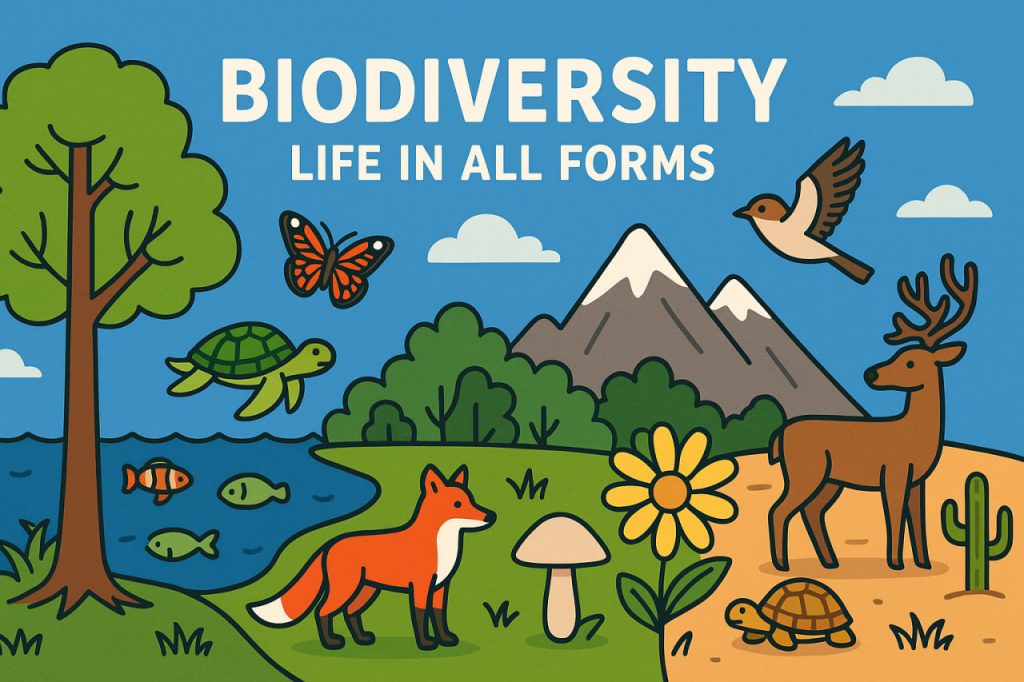Biodiversity, or biological diversity, refers to the variety of life on Earth. It includes all plants, animals, fungi, and microorganisms, the ecosystems they form, and the genetic variation within each species. From towering rainforests to tiny soil microbes, biodiversity shapes the foundation of life—and supports the natural systems we depend on every day.
Levels of Biodiversity
Biodiversity exists on three interconnected levels:
- Genetic diversity: The variation in genes within a species. It allows organisms to adapt to changing environments.
Example: Different breeds of dogs or genetic traits in wild tigers. - Species diversity: The variety of species in an ecosystem or on the planet.
Example: Coral reefs support thousands of fish, coral, and algae species. - Ecosystem diversity: The range of habitats and ecological processes, from forests to deserts to wetlands.
Example: A mountain range with forests, meadows, rivers, and caves.
Each level plays a critical role in maintaining ecological balance and resilience.
Why Is Biodiversity Important?
Biodiversity is essential to both the environment and human well-being:
- Ecosystem services: Healthy ecosystems purify air and water, pollinate crops, decompose waste, and regulate climate.
- Food and agriculture: Diverse species provide fruits, vegetables, grains, fish, and livestock.
- Medicine: Many modern drugs are derived from plants, fungi, and marine organisms.
- Cultural and spiritual value: Nature holds meaning in traditions, religions, and recreation.
- Resilience to change: Ecosystems with high biodiversity are more stable and adaptable to climate shifts and disease outbreaks.
Biodiversity Hotspots
Certain regions host exceptionally high species richness. These biodiversity hotspots include:
- Amazon Rainforest – home to 10% of all known species
- Coral Triangle – the most diverse marine region on Earth
- Madagascar – 90% of its wildlife is found nowhere else
- Himalayas – rich in endemic plants and animals
Protecting these areas is a global priority.
Threats to Biodiversity
Biodiversity is declining rapidly due to human activity. Major threats include:
- Habitat loss from deforestation, agriculture, and urbanization
- Pollution of air, water, and soil
- Climate change, causing shifts in species ranges and weather extremes
- Overexploitation from hunting, fishing, and resource extraction
- Invasive species that outcompete native ones
- Disease transmission from humans to wildlife
We are currently experiencing a biodiversity crisis, with up to 1 million species at risk of extinction.
How to Protect Biodiversity
Every person can help protect biodiversity through:
- Conserving habitats and supporting protected areas
- Reducing pollution and carbon emissions
- Using sustainable products (e.g., certified wood, organic food)
- Protecting pollinators and planting native species
- Educating others about the importance of biodiversity
Governments and organizations must also enforce environmental laws, restore ecosystems, and invest in science and conservation.
Conclusion
Biodiversity is the web of life that sustains our planet. It provides the oxygen we breathe, the food we eat, and the natural systems that keep Earth habitable. Safeguarding it is not just about saving wildlife—it’s about preserving life itself, including our own.
Glossary
- Biodiversity: The variety of life forms and ecosystems on Earth
- Genetic diversity: Differences in genes within a species
- Ecosystem: A community of living organisms interacting with their environment
- Endemic species: A species found only in one specific location
- Habitat loss: The destruction of natural areas where species live


